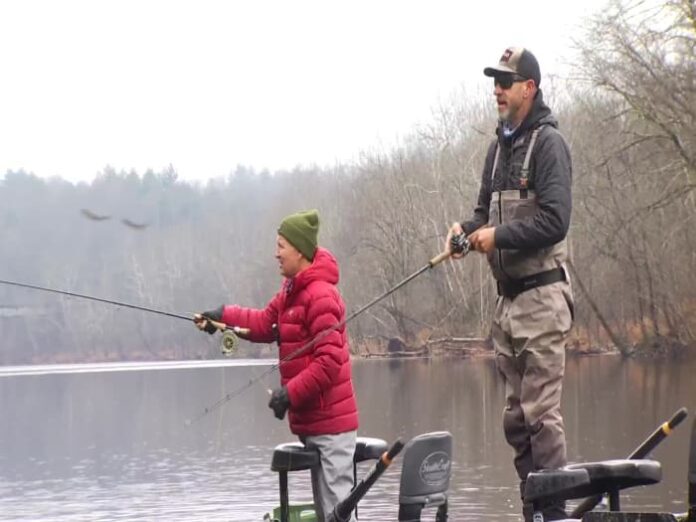It was a cold and rainy day in early December — perfect weather for Musky fishing.
If you don’t know what that is, think of a barracuda, with big teeth that lives in freshwater, and they can be up to 4 feet long, even in the James River.
“I wouldn’t say it’s typical, but it’s a great musky day. It’s musky weather,” said Austin Conrad, one of two guides from Virginia Trophy Guides, who specialize in Musky fishing – when they are not seeking huge trout, or guiding in Alaska during the summer months.
“Overcast. Low light. A little bit of precipitation keeping the river up and a little less clear that James River Green we all know and love,” Conrad said as he rowed the fishing raft out into the cold water.
Muskies — sulking predators among the biggest of freshwater fish — love cold water. The James and New rivers in particular are perfect for them. The water temperature doesn’t get too hot in the summer, and in the winter they are really in their element.
If you want to catch one of these monsters in Virginia, winter is the time to do it.
And even then – it’s not easy.
“We say, you know, you just gotta embrace the suck if you will. It’s not always fun,” admitted Josh Laferty, the other guide on the trip.
For many others, and me, it’s a bucket list fish. The top of the food chain — an apex predator. The only threat to a musky is a bigger musky.
The hunt
So here I was, watching the rain drip off my forehead as the low mist blotted out the nearby scenery, trying to solve the musky puzzle.
“It’s probably more akin to hunting than what a lot of people would traditionally think that fishing is. It’s uniquely challenging. The flies are big the lures are big,” Laferty said.
The hope was to catch one on a fly rod – which is somewhat flimsy compared to conventional fishing tackle and therefore more of a challenge for the angler. But in less than an hour, my arm was exhausted from trying to throw the massive fly.
This effort left me spent and produced not a single fish.
No real surprise since the musky is known as the fish of 10,000 casts.
In part because they often just aren’t hungry.
“They don’t have to eat all the time. So it’s not like us where we tend to think that we need three meals a day. These fish can eat the right meal once every 2 to 3 days,” Laferty said.
I just think of muskies as ornery.
“They are masters of their environment just like most big predators, whether they’re on land or in the water. They’re masters of their domain. They live in a tough place. It’s a tough world out here and they’re kind of one of those things, they’re so ugly they’re beautiful,” Laferty said as if apologizing for the fish’s uncooperative nature.
If you are going to catch one in Virginia, however, the James and New Rivers are the place to try.
The state began stocking these big fish in these rivers back in the 1960′s – and now they are reproducing in the James to the point where stocking is no longer necessary.
Still. It sure seemed like a lot of casting.
Adding to my arm fatigue – something called the musky figure 8 thing.
Once you get the cast back to the boat, you always drag the lure through the water again in a figure-eight pattern – because they often strike right at your feet.
“These fish can come up off the bottom out of nowhere. So all of a sudden it’s ‘we haven’t seen anything and then bam there one is,” Laferty said.
Then, Josh’s musky senses flared a bit…
“I think we’re going to get one between here and that last Sycamore that’s in sight there,” he predicted
And before I knew it, there was a musky on the end of my line.
I got it to a net that seemed big enough to hold a human, and there was instantly a lot of high-fiving and fist-bumping.
The fish was about 30 inches long. A big fish, but a small musky. It was a beautiful shade of light green, with camouflage-type markings on its side.
“These fish, it’s a northern strain that the game department stocked in here and they’re pretty diverse. A lot of times when they’re small or younger like this, you’ll see more of the sparring and coloring in them see how those colors just change,” Laferty explained.
I released the fish unharmed, and it swam back into the cold depths of the James.
With my heart racing, we returned to fishing, hoping to see the larger cousin to my fish.
Despite the weather and my aching shoulder, it was important to keep the day’s activities in perspective. People come from all over to do this, despite the cold conditions.
“We have people from the West Coast even. It’s a fish that people travel for because it is a trophy fish. It’s a bucket list fish for a lot of anglers,” Conrad said.
The longer we fished, the harder it rained.
We headed for the car, knowing that somewhere in the upper James River there is a 40+ inch monster with my name on it.
Maybe next time.
For information of fishing for Muskies in Virginia, check out the Virginia DWR and Virginia Trophy Guides.
Copyright 2022 by WSLS 10 – All rights reserved.
Credit: Source link






























